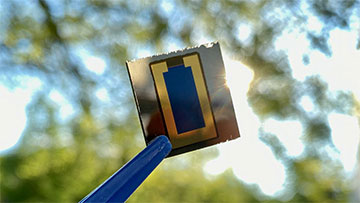
Perovskite/CIS tandem solar cells are already able to convert a relatively high fraction of incident light into electric current. Future refinements can further improve efficiency. [Image: M.A. Ruiz-Preciado, KIT]
Advancements in single-junction silicon solar cells over the last decades have led to notable improvements in efficiency to the point where they now approach the practical limit. One approach to pushing photovoltaic performance even further is stacking compatible solar cells in a tandem configuration to capture more of the solar spectrum.
Researchers from Karlsruhe Institute of Technology, Germany, and TNO Partner in Solliance, Netherlands, have created two-terminal tandem solar cells using perovskite, a low-cost material that has shown immense potential, and copper-indium-diselenide (CIS) (ACS Energy Lett., doi: 10.1021/acsenergylett.2c00707). The all-thin-film devices, which achieved a power-conversion efficiency (PCE) close to 25%, represent a path toward lightweight, flexible photovoltaics.
A fitting partner for perovskite
Perovskite solar cells are known as the fastest-improving solar technology to date, with PCEs soaring from 3.8% to 25.7% since their invention in 2009. Tandem solar cells made with perovskite and crystalline silicon have reached a record PCE of over 29%. However, the addition of silicon can lead to panels that are fragile, rigid and fairly expensive to manufacture.
These disadvantages have prompted researchers to search for alternative materials to pair with perovskite. One promising material is CIS, which, like perovskite, enables a thin-film device architecture, meaning that an all-thin-film tandem solar cell could feasibly be produced.
“Perovskite/CIS tandem photovoltaics promise to reach, soon, high power-conversion efficiencies exceeding 30% and with all the benefits of a lightweight and flexible thin-film photovoltaic technology,” said senior author Ulrich Paetzold, a professor at Karlsruhe Institute of Technology. “The latter is relevant for a number of markets, such as industrial rooftops that cannot withstand heavy modules [as well as] vehicle-integrated photovoltaics.”
Pushing for higher efficiencies
First, Paetzold and his colleagues performed computational simulations to find the ideal band-gap combinations for a perovskite/CIS tandem solar cell. They wanted to leverage the fact that band gaps of both the perovskite top cell and the CIS bottom cell can be tuned by changing their compositions. Also, to connect the top and bottom cells in series as a two-terminal device, their photocurrents must match, which requires a suitable combination of band gaps.
In the end, the researchers combined a low-Ga-containing CIS with a band gap of 1.03 eV and a triple-cation perovskite with a band gap of 1.59 eV. The solar cell also included an antireflective coating to improve light in-coupling and increase the overall photocurrent.
“By optimizing the semi-transparent perovskite top cell when it is interconnected in tandem with a narrow-band-gap CIS bottom cell, we obtain tandem photovoltaic devices approaching a PCE of 25%,” said Paetzold. “Our study demonstrates that perovskite/CIS tandem solar cells have the potential to reach PCEs exceeding our current results, paving the way for future developments that might push the efficiencies over the 30% threshold.”
Next steps for commercialization
While the higher PCE is another step forward for two-terminal perovskite/CIS tandem solar cells, much work is still needed before the technology can enter the market. Paetzold emphasizes that the open challenges to solve are the scalability of materials and fabrication processes, as well as necessary improvements in stability. In particular, perovskites degrade and decompose when exposed to prolonged moisture, oxygen and heat.
“More work on stability is needed to demonstrate the required 20 to 30 years of stable device performance that silicon photovoltaics—the market-dominating photovoltaic technology—offer,” he said.
